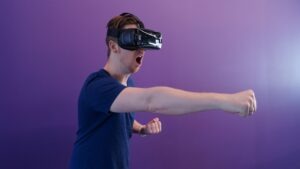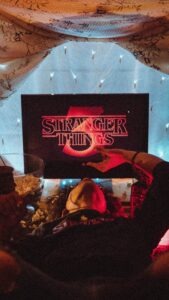Virtual reality and pain reduction
Studenten Applied Psychology & Technology schreven afgelopen semester (2022-2023) samen blogberichten. De 3 beste berichten, over virtual reality en pijnreductie, sociale media en alcoholmisbruik bij studenten en binge-watchen kan je hier nalezen.
Door Lucas Vervaecke & Alena Thöni
There’s nothing #technology can’t do. Recent #VR research shows promising results: is #virtualreality the innovative solution to give patients a break from #chronicpain?
Introduction
Chronic pain is difficult to treat, and it often happens that painkillers are insufficient. It is also the case that the side effects and costs of these are disruptive for long-term use (Wittkopf et al., 2019). But before we start with possible solutions, we first need to clarify how we end up with pain.
According to the neuromatrix theory of pain, cognitive, sensory, and affective inputs, as well as factors that influence them (such as attention), can partially change your pain and the response hierarchy disappears (Melzack, 2001). So, for example, if you are distracted then it is possible that you feel this pain much less. Virtual reality seems to be a very good way for this method.

How VR works
But distraction isn’t the only way VR is being used to reduce pain perception. From a review by Ahmadpour et al., (2020) they were able to recognize 3 targets of VR interventions.
1. Distraction
Tapping into the patient’s concentration using entertaining videos or games.
2. Change focus
respond to the patient’s cognitive resources through virtual tasks (e.g. tracking multiple objects).
3. Capacity or skill building
Teaching the patient the possibility of self-regulation using game-driven activities.
The use of VR for healthcare was pioneered by Hoffman et al. (2000) who had developed a VR video game (SnowWorld). This has been successfully used during the care of severe burns to reduce patients’ pain perception, in other words to distract them from the pain. It didn’t solve the problem, but the patients had a significant reduction in pain (65% of patients had an 34% reduction in worst pain).
Several games have also been made that did not necessarily only change the focus as a goal, but where this simply fits into this category. An example of this is Pizkorz and Czub’s (2018) trial that used a Multiple Object Tracking paradigm during a painful procedure. That is a virtual game in which players must remember and follow multiple moving objects. Here, the players had reported a significantly lower pain intensity compared to the control group (mean pain intensity = 15.16 ± 20.51 vs. 37.05 ± 30.66).
The trial was conducted to teach patients with chronic pediatric headaches to better control their mental state. By focusing to get from stress to a calmer mental state, where they then receive immediate visual feedback. Each person who participated experienced significant headache relief (Shiri et al., 2013).

Implementing games in healthcare is nothing new. Games have been tested before to distract people from their pain. Unfortunately, VR treatment for chronic pain is relatively new and more research needs to be done. It is also the case that all treatment methods (not just VR) of chronic pain do not work equally well for everyone.
Advantages and disadvantages of using VR applications in chronic pain treatments
Following the explanation of how VR can be used in pain therapy the question arises, what the advantages and disadvantages of this technology, used in pain treatment, are. There’s a wide range of arguments in this regard. One of the biggest advantages is that the use of VR technologies in pain treatment offers a treatment without pharmaceutical alternatives (Ahmadpour et al., 2020).
On the other hand, it is also important to be aware of the disadvantage of accessibility as well as occurring difficulties in the application, depending on the intensity of pain. Therefore, people with complicated health needs are excluded from the therapy, although they would need it the most (Ahmadpour et al., 2020), just because it is too complicated to apply it to an impaired body. Yet in the case of stroke patients, VR therapy proves to be effective because it is not only analgesic, but one can also target and exercise damaged brain regions, thus counteracting the lesion (Sato et al., 2010).
Probably the most obvious and therefore most promising advantage of VR use is the ability to provide patients with a pain-free environment that distracts from acute pain during painful medical procedures, but also acts as an escape possibility for chronic pain patients (Shiri et al., 2013).
 When we talk about disadvantages, there’s a need to mention the design of the VR applications. If it should really be used as an alternative therapy to relief pain, the design must be suitable for the patient’s context. The VR experience must be satisfying and non-frustrating for the user, which means it’s important to include normal positive environments in the VR (Garrett et al., 2020).
When we talk about disadvantages, there’s a need to mention the design of the VR applications. If it should really be used as an alternative therapy to relief pain, the design must be suitable for the patient’s context. The VR experience must be satisfying and non-frustrating for the user, which means it’s important to include normal positive environments in the VR (Garrett et al., 2020).
Also, the technical operation often seems to be a barrier for the effective usage of VR applications. Considering, that people with chronic pain are often not able to walk around a room or even stand up right (Garrett et al., 2020). So, to conclude this part, yes VR seems very promising in the treatment of chronic pain although it must be mentioned that there are no peer reviewed studies which confirm the efficacy in chronic pain on a long-term scale (Gromala et al., 2015).
Is it a potential solution for medicine to manage chronic pain?
Considering the ongoing opioid crisis, we see especially in North America and industrialized nations (Gromala et al., 2015), having an option to treat pain and relief the patients is promising and motivating. The VR pain therapy offers a treatment completely without the risks of the side effect pharmaceutic alternatives have, e.g., opioid dependency (Ahmadpour et al., 2020).
But, to get to the point where this kind of therapy can be offered to all patients with chronic or acute pain, the applications need to be optimized. That’s why it’s recommended to include the patients in the design process because pain experiences differ from individual to individual.
To sum it up, VR can be a very promising application to relief people from pain or at least offer them a temporary escape out of their painful reality.

Bibliography
Ahmadpour, N., Keep, M., Janssen, A., Rouf, A. S., & Marthick, M. (2020). Design Strategies for Virtual Reality Interventions for Managing Pain and Anxiety in Children and Adolescents: Scoping Review. JMIR Serious Games, 8(1), e14565. https://doi.org/10.2196/14565
Garrett, B. M., Tao, G., Taverner, T., Cordingley, E. & Sun, C. (2020). Patients perceptions of virtual reality therapy in the management of chronic cancer pain. Heliyon, 6(5), e03916. https://doi.org/10.1016/j.heliyon.2020.e03916
Gromala, D. G., Tong, X. T., Choo, A. C., Karamnejad, M. K. & Shaw, C. D. S. (2015). The Virtual Meditative Walk: Virtual Reality Therapy for Chronic Pain Management. Simon Fraser University.
Hoffman, H. G., Doctor, J. N., Patterson, D. R., Carrougher, G. J., & Furness, T. A. (2000). Virtual reality as an adjunctive pain control during burn wound care in adolescent patients. Pain, 85(1), 305–309. https://doi.org/10.1016/S0304-3959(99)00275-4
Melzack, R. (2001). Pain and the neuromatrix in the brain. Journal of Dental Education, 65(12), 1378–1382.
Piskorz, J., & Czub, M. (2018). Effectiveness of a virtual reality intervention to minimize pediatric stress and pain intensity during venipuncture. Journal for Specialists in Pediatric Nursing, 23(1), e12201. https://doi.org/10.1111/jspn.12201
Sato, K., Fukumori, S., Matsusaki, T., Maruo, T., Ishikawa, S., Nishie, H., Takata, K., Mizuhara, H., Mizobuchi, S., Nakatsuka, H., Matsumi, M., Gofuku, A., Yokoyama, M., & Morita, K. (2010). Nonimmersive Virtual Reality Mirror Visual Feedback Therapy and Its Application for the Treatment of Complex Regional Pain Syndrome: An Open-Label Pilot Study. Pain Medicine, 11(4), 622–629. https://doi.org/10.1111/j.1526-4637.2010.00819.x
Shiri, S., Feintuch, U., Weiss, N., Pustilnik, A., Geffen, T., Kay, B., Meiner, Z., & Berger, I. (2013). A Virtual Reality System Combined with Biofeedback for Treating Pediatric Chronic Headache—A Pilot Study. Pain Medicine, 14(5), 621–627. https://doi.org/10.1111/pme.12083
Wittkopf, P. G., Lloyd, D. M., & Johnson, M. I. (2019). Managing limb pain using virtual reality: A systematic review of clinical and experimental studies. Disability and Rehabilitation, 41(26), 3103–3117. https://doi.org/10.1080/09638288.2018.1485183
Interessante berichten
Bachelorproefproject – Soft skills in VR
Je spreekangst overwinnen? Dat kan binnenkort in virtual reality Een nieuwe VR-applicatie die wordt ontwikkeld door de Thomas More-hogeschool heeft…
Lees meerBachelorproefproject – Virtual reality in woonzorgcentra
De Expertisecel Psychologie, Technologie en Samenleving wou inzicht kijrgen in drempels en factoren die ervoor zorgen dat virtuele technologie gemakkelijker…
Lees meer

 There are several reasons for binge-watching (Starosta & Izydorczyk, 2020). Watching a series can help to avoid reality, and can be a way to cope with negative emotions and deal with loneliness. People tend to binge-watch because of the transportation into a fictional world, which is related to high emotional and cognitive engagement. Another reason can be FOMO, which means Fear of Missing out. Motivation for watching hours and hours from one series can also be that people want to feel able to join conversations. Beside all these reasons, binge-watching is a simple way to satisfy our needs. For example, it gives us the feeling of gratification (Rubenking & Bracken, 2021). Factors driving us even more to binge watch can be our family or friends or simply the need for entertainment or a way to procrastinate (Gangadharbatla et al., 2019).
There are several reasons for binge-watching (Starosta & Izydorczyk, 2020). Watching a series can help to avoid reality, and can be a way to cope with negative emotions and deal with loneliness. People tend to binge-watch because of the transportation into a fictional world, which is related to high emotional and cognitive engagement. Another reason can be FOMO, which means Fear of Missing out. Motivation for watching hours and hours from one series can also be that people want to feel able to join conversations. Beside all these reasons, binge-watching is a simple way to satisfy our needs. For example, it gives us the feeling of gratification (Rubenking & Bracken, 2021). Factors driving us even more to binge watch can be our family or friends or simply the need for entertainment or a way to procrastinate (Gangadharbatla et al., 2019).
 Hallo! Ik ben Kimberley Bruggeman en loop van augustus tot maart 2023 mijn eindstage binnen de expertisecel Psychologie, Technologie en samenleving. Mijn academische carrière begon aan de Thomas More hogeschool waar ik mijn bachelorsdiploma heb behaald in de toegepaste klinische psychologie. Mijn passie voor onderzoek heb ik ook hier mogen ontdekken tijdens mijn exploratiestage aan de KU Leuven. Hier werkte ik aan onderzoek naar Religie en Zingeving op latere leeftijd met speciale aandacht voor vergeving en hechting. Na een schakeljaar ben ik nu bezig aan de masteropleiding theoretische en experimentele psychologie aan de Universiteit Gent. Ik ben enthousiast om te mogen leren over en (hopelijk) bijdragen aan het steeds groeiende domein van onderzoek naar de toepassing van technologie in mentale gezondheidszorg.
Hallo! Ik ben Kimberley Bruggeman en loop van augustus tot maart 2023 mijn eindstage binnen de expertisecel Psychologie, Technologie en samenleving. Mijn academische carrière begon aan de Thomas More hogeschool waar ik mijn bachelorsdiploma heb behaald in de toegepaste klinische psychologie. Mijn passie voor onderzoek heb ik ook hier mogen ontdekken tijdens mijn exploratiestage aan de KU Leuven. Hier werkte ik aan onderzoek naar Religie en Zingeving op latere leeftijd met speciale aandacht voor vergeving en hechting. Na een schakeljaar ben ik nu bezig aan de masteropleiding theoretische en experimentele psychologie aan de Universiteit Gent. Ik ben enthousiast om te mogen leren over en (hopelijk) bijdragen aan het steeds groeiende domein van onderzoek naar de toepassing van technologie in mentale gezondheidszorg. Hallo, ik ben Audrey Verrall. Ik ben een stagiaire aan de expertisecel voor een periode van 6-maanden startende in augustus 2022 tot februari 2023. Deze stage is de laatste stap in het behalen van mijn masterdiploma in de Theoretische- en Experimentele Psychologie (UGent). Ik ben enthousiast om een deel uit te mogen maken van dit geweldige team omdat het me de kans geeft om meer ervaring op te doen binnen toegepast onderzoek en meer bepaald in de potentiële positieve bijdragen van technologie op mentale gezondheid. Dit is een mooie toevoeging aan de theoretische inzichten die ik reeds vergaarde gedurende mijn master thesis over de effecten van ‘resonance breathing’ op ruminatie en affect en de meer praktijkgerichte skills die ik heb verworven door het beoefenen van mindfulness.
Hallo, ik ben Audrey Verrall. Ik ben een stagiaire aan de expertisecel voor een periode van 6-maanden startende in augustus 2022 tot februari 2023. Deze stage is de laatste stap in het behalen van mijn masterdiploma in de Theoretische- en Experimentele Psychologie (UGent). Ik ben enthousiast om een deel uit te mogen maken van dit geweldige team omdat het me de kans geeft om meer ervaring op te doen binnen toegepast onderzoek en meer bepaald in de potentiële positieve bijdragen van technologie op mentale gezondheid. Dit is een mooie toevoeging aan de theoretische inzichten die ik reeds vergaarde gedurende mijn master thesis over de effecten van ‘resonance breathing’ op ruminatie en affect en de meer praktijkgerichte skills die ik heb verworven door het beoefenen van mindfulness. Hoi, ik ben Fien Buelens en loop van januari tot juli stage bij de expertisecel Psychologie, Technologie en Samenleving. Vorig jaar studeerde ik af als Master in Klinische Psychologie voor Volwassen aan de KU Leuven. Tijdens mijn eindstage in CGG VAGGA groeide mijn interesse voor het onderzoeksluik achter de klinische praktijk. Daarom volg ik dit jaar de Verkorte Master Theorie en Onderzoek aan de KU Leuven en loop ik stage bij de expertisecel van Thomas More. De stage is voor mij een perfecte match tussen mijn twee grote interesses: het verbeteren van de mentale gezondheid en het toepassen van onderzoek. Ik vind het ook interessant om technologie te betrekken in beide zaken. Ik ben benieuwd naar het ontdekken van nieuwe, technologische mogelijkheden om mentale gezondheid te kunnen verbeteren. Daarbuiten hoop ik zelf ook te kunnen bijdragen aan het onderzoekveld.
Hoi, ik ben Fien Buelens en loop van januari tot juli stage bij de expertisecel Psychologie, Technologie en Samenleving. Vorig jaar studeerde ik af als Master in Klinische Psychologie voor Volwassen aan de KU Leuven. Tijdens mijn eindstage in CGG VAGGA groeide mijn interesse voor het onderzoeksluik achter de klinische praktijk. Daarom volg ik dit jaar de Verkorte Master Theorie en Onderzoek aan de KU Leuven en loop ik stage bij de expertisecel van Thomas More. De stage is voor mij een perfecte match tussen mijn twee grote interesses: het verbeteren van de mentale gezondheid en het toepassen van onderzoek. Ik vind het ook interessant om technologie te betrekken in beide zaken. Ik ben benieuwd naar het ontdekken van nieuwe, technologische mogelijkheden om mentale gezondheid te kunnen verbeteren. Daarbuiten hoop ik zelf ook te kunnen bijdragen aan het onderzoekveld.

 Hallo, ik ben Ben Genné en ik loop van maart tot juni stage bij de expertisecel. In kader van de exploratiestage binnen de opleiding Toegepaste Psychologie, ben ik al eens in contact gekomen met het onderzoeksveld. Dit vond ik een zeer toffe ervaring waardoor ik niet twijfelde om hier verder in te gaan binnen mijn eindstage. Zelf ben ik iemand die zeer nieuwsgierig maar vooral leergierig is. Ik ben dan ook enorm benieuwd naar de interactie tussen technologische toepassingen en mentale gezondheid. Het ontdekken van hoe het eraan toe gaat in de praktijk lijkt me een echte uitdaging. Ik hoop dan ook een belangrijke bijdrage te kunnen leveren aan de lopende projecten.
Hallo, ik ben Ben Genné en ik loop van maart tot juni stage bij de expertisecel. In kader van de exploratiestage binnen de opleiding Toegepaste Psychologie, ben ik al eens in contact gekomen met het onderzoeksveld. Dit vond ik een zeer toffe ervaring waardoor ik niet twijfelde om hier verder in te gaan binnen mijn eindstage. Zelf ben ik iemand die zeer nieuwsgierig maar vooral leergierig is. Ik ben dan ook enorm benieuwd naar de interactie tussen technologische toepassingen en mentale gezondheid. Het ontdekken van hoe het eraan toe gaat in de praktijk lijkt me een echte uitdaging. Ik hoop dan ook een belangrijke bijdrage te kunnen leveren aan de lopende projecten.